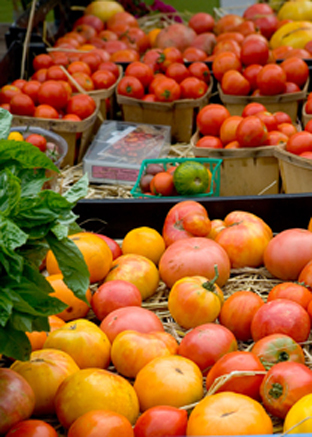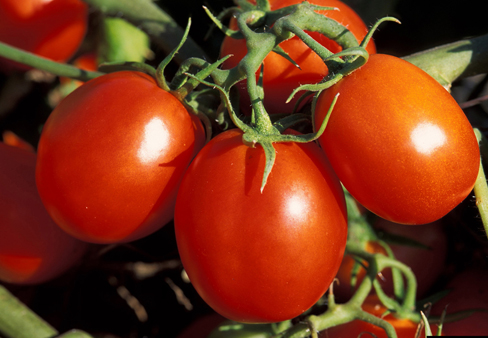Tomatoes
Tomato (Lycopersicon esculentum) is a warm-season crop that originated in South America. Tomatoes are one of the most popular and profitable crop alternatives in Kentucky. Growers able to provide the earliest locally grown tomatoes can often demand a premium price.
Marketing
 Tomatoes are grown in Kentucky primarily for fresh market sales. Fresh market options include roadside stands, local wholesalers and retailers, national wholesale markets, community supported agriculture (CSA) subscriptions, produce auctions, local restaurants, and farmers markets. Season extension techniques, especially high tunnel and greenhouse tomato production, have resulted in a longer marketing season for Kentucky-grown tomatoes. Planting for very early or for late fall markets may be more profitable because prices tend to be higher. More popularity of locally produced tomato-based products, like salsas and sauces, has created some market niches for tomatoes grown for processing in Kentucky. Although there is a significant processing tomato industry in Indiana and other nearby states, Kentucky grows only a small acreage of tomatoes for processing. This is probably because of the lack of processors close by; tomato processors usually contract directly with farmers to grow mechanically harvested tomatoes for processing. New tomato producers in Kentucky usually begin selling tomatoes in lower-volume, direct markets like farmers markets or on-farm stands.
Tomatoes are grown in Kentucky primarily for fresh market sales. Fresh market options include roadside stands, local wholesalers and retailers, national wholesale markets, community supported agriculture (CSA) subscriptions, produce auctions, local restaurants, and farmers markets. Season extension techniques, especially high tunnel and greenhouse tomato production, have resulted in a longer marketing season for Kentucky-grown tomatoes. Planting for very early or for late fall markets may be more profitable because prices tend to be higher. More popularity of locally produced tomato-based products, like salsas and sauces, has created some market niches for tomatoes grown for processing in Kentucky. Although there is a significant processing tomato industry in Indiana and other nearby states, Kentucky grows only a small acreage of tomatoes for processing. This is probably because of the lack of processors close by; tomato processors usually contract directly with farmers to grow mechanically harvested tomatoes for processing. New tomato producers in Kentucky usually begin selling tomatoes in lower-volume, direct markets like farmers markets or on-farm stands.
Production

Cultivar selection is a critical decision for commercial tomato growers, but with thousands of varieties available it can seem a daunting task. Cultivars differ in such horticultural traits as fruit characteristics (e.g. size, color, shape, flavor and intended use), earliness (early, mid- and late-season), growth habit (determinate and indeterminate), and disease resistance. Consideration needs to be given to regional preferences, as well as whether to grow hybrids and/or heirloom cultivars. Growers should select only adapted varieties that have the qualities in demand for the intended market.
See the full crop profile and other resources below:
CCD Tomatoes Profile (CCD-CP-98) (pdf)
Tomato Budget (U. Kentucky)
Small-Scale Tomato Budget (U. Tennessee)
Enterprise Budget for Cherry Tomatoes (Practical Farmers of Iowa)
CCD Greenhouse Tomatoes Profile (CCD-CP-57) (pdf)
CCD High Tunnel Tomatoes Profile (CCD-CP-62) (pdf)
Rotating Cut Flowers Within a Tomato High Tunnel Production System Fact Sheet (CCD-FS-23) new! (pdf)
CCD Organic Tomatoes Profile (CCD-CP-111) (pdf)

